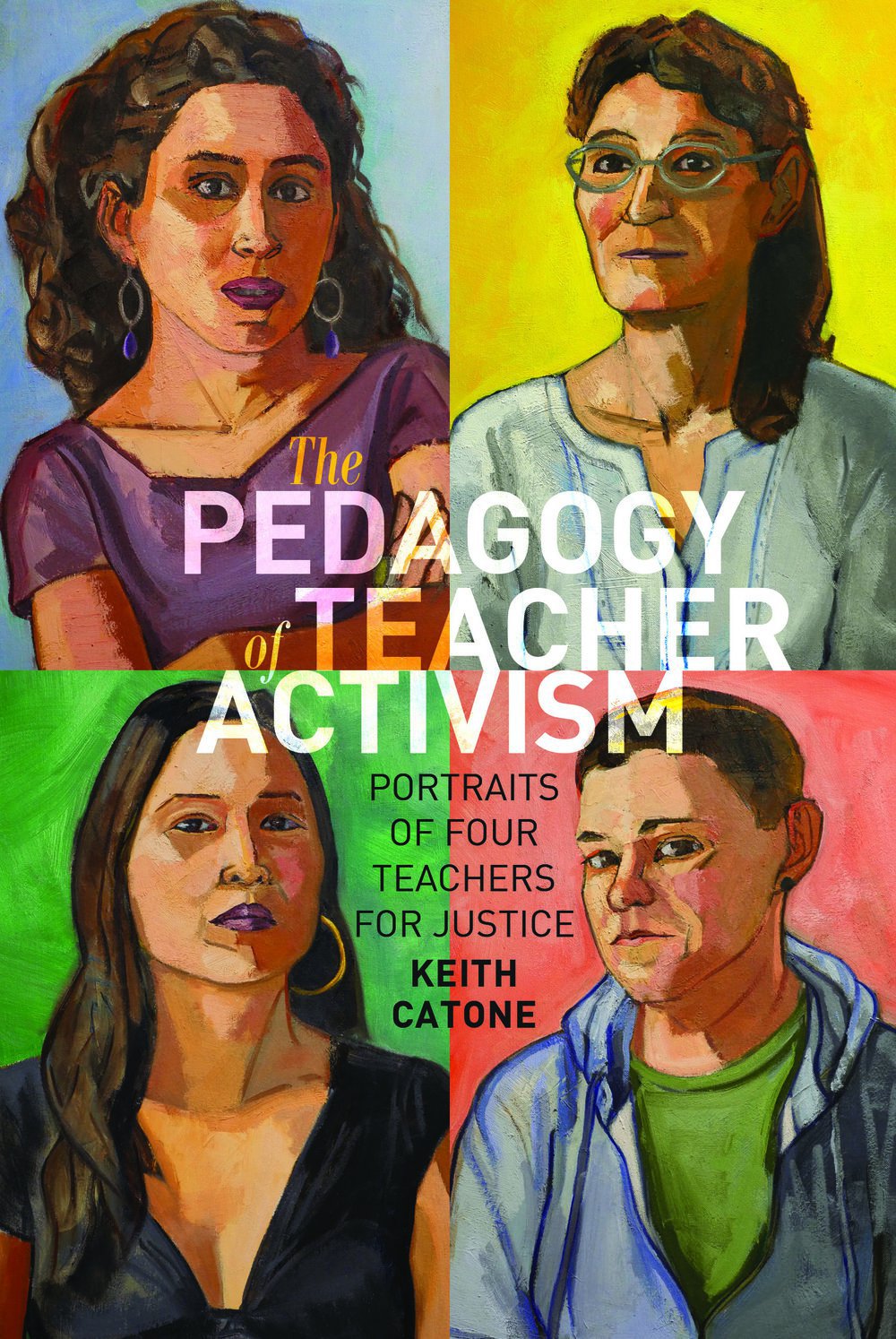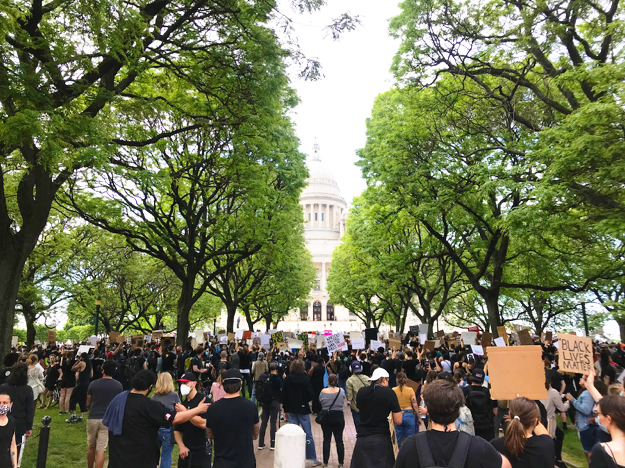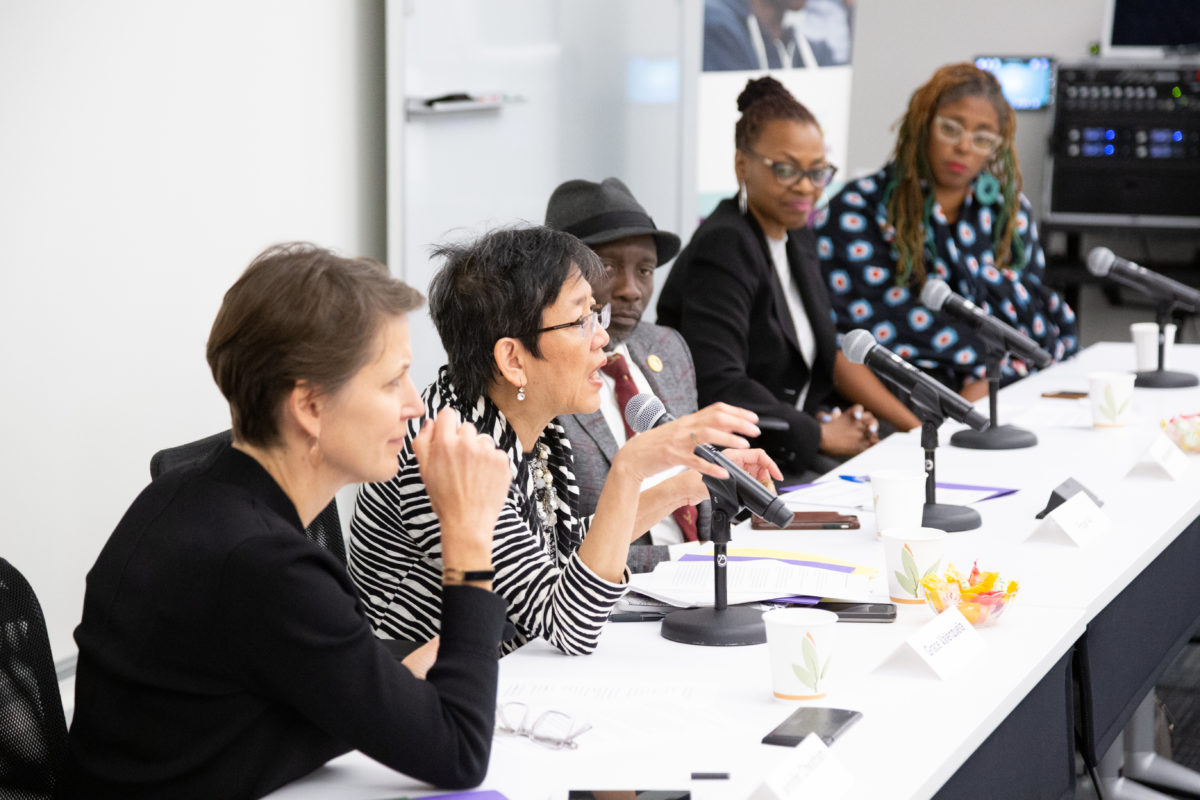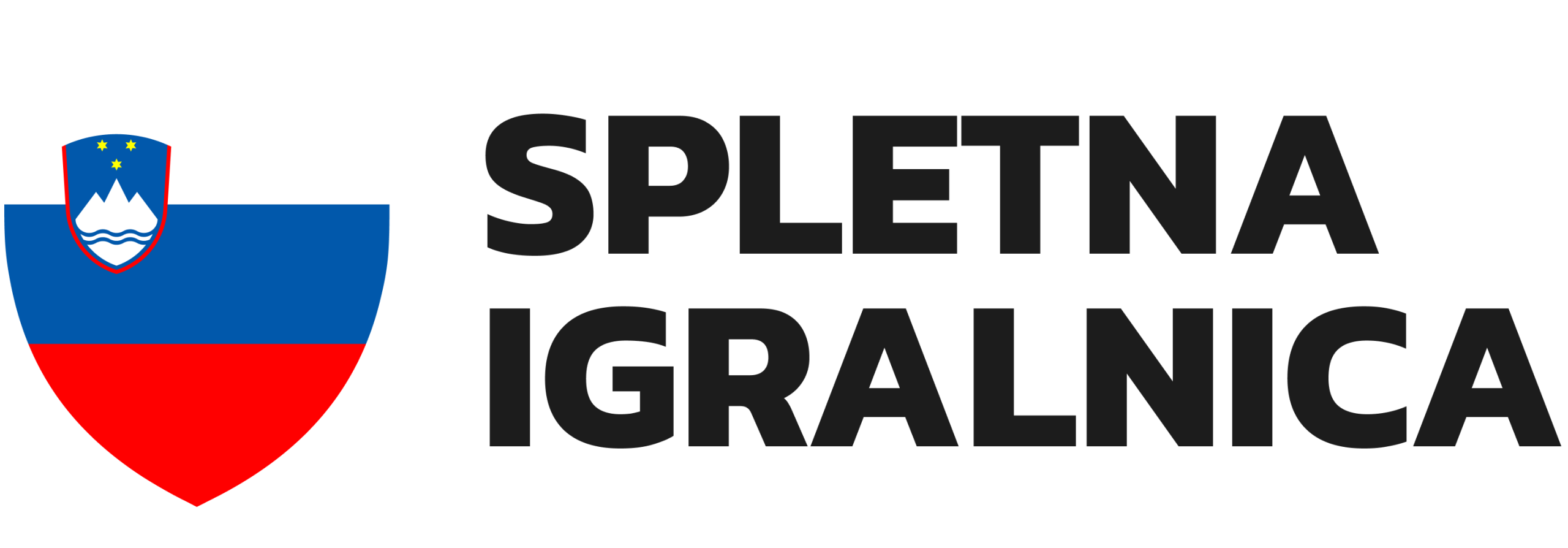As the founding executive director of the Center for Youth and Community Leadership in Education at Roger Williams University, Keith Catone is committed to partnering with communities and schools seeking to build collective power to fight for and win education policies and practices that create equitable opportunities and just outcomes for all learners. Catone was formerly the associate director of community organizing and engagement at Brown University’s Annenberg Institute for School Reform and the project director for the Youth 4 Change Alliance in Providence, Rhode Island. He also taught at Banana Kelly High School in the South Bronx and co-founded the New York Collective of Radical Educators, a citywide teacher-activist organization. His book, The Pedagogy of Teacher Activism: Portraits of Four Teachers for Justice, was published in 2017.
Follow Keith Catone on Twitter →
Interview by Stephen Abbott
Q: You got started in community organizing as a teacher activist. What compelled you to start the New York Collective of Radical Educators?
Even as an undergraduate, I had always connected the work of public education to social change. When I became a teacher, I sought out ways to connect what I was doing to work in the social-justice movement, but I found that this wasn’t easy. In 2001, after 9/11, I started to get involved in a lot of anti-war activism in New York City, and I connected with other teachers who were also involved in the movement. A year later, a few of us remained connected and started to talk about how there should be clearer avenues for public-school educators to engage in social-justice work—not just though our teaching and work inside schools, but also as activists working outside of schools with the communities we serve.
Because we were all initially connected through the post-9/11 anti-war context, we first started to work on an anti-military-recruitment campaign and curriculum project. We partnered with local anti-war groups, including a youth-led organization called the YA-YA Network—YA-YA stands for Youth Activists–Youth Allies—which was focused on the increased presence of military recruiters in low-income communities of color throughout NYC and the ways that No Child Left Behind facilitated that recruitment. This work, which we conducted in partnership with community organizations, grounded our perspective and commitment to figuring out how to build a teacher-activist organization that could connect more educators to social-justice movements. When we started to organize public meetings and put ourselves out there as a group of educators committed to social justice, we found a lot of like-minded educators who also wanted to get involved and a lot of organizations interested in connecting with teachers. So that’s basically how NYCoRE came together.
Q: Teachers report—and I’m getting this from a national study by the Learning Policy Institute—that unsupportive administrators are a significant source of job dissatisfaction and turnover, and that being locked out of decision-making and leadership roles in schools are contributing factors. What are the common administrative missteps you’ve observed when it comes to teacher engagement or shared leadership in schools?
One common misstep is a top-down approach to securing so-called “teacher buy-in” for ideas that are already fully developed or were preconceived by administrators. This is a more general leadership challenge that can be observed in any number of professions and industries, but in schools, where there is often a focus—or at least an espoused focus—on teacher leadership, it can be unclear exactly what teachers are truly being asked to lead. This failure to clearly define roles—to precisely describe where teacher leadership begins and ends, for example—is in itself a common source of frustration and resentment among teachers when they are told that a school wants to practice distributed leadership, but then lacks structure, clarity, and support for how leadership can be exercised.

In an attempt to protect teachers from additional work, which is not a bad impulse, administrators will often cook up detailed plans to roll out a new initiative, policy, or practice at the school level; in other cases, administrators just have power issues or difficulty sharing leadership, so formulating plans without teacher involvement is sometimes an assertion of authority and control. After rolling out these plans to teachers, administrators are then perplexed about why many do not seem to implement the plans with fidelity, energy, or enthusiasm.
The failure of these “best-laid” plans are often not related to the plans themselves—to the goals, let’s say, or the practices they recommend—but to the processes by which they were developed. The best way—really, the only way—to ensure true teacher buy-in is to invest in teacher leadership from the start. That not only means that teachers should be at the table when the first decisions are being about any new initiative, but it also means that schools should be investing time and money in leadership-development programs for teachers or creating shared-governance systems that empower teachers with real decision-making authority.
I sometimes use a metaphor that can be instructive here. Most things that we buy as consumers depreciate in value as soon as they’re purchased. We may get some initial satisfaction from a newly bought product, but inevitably, over time, the quality of the product declines and we need to find a replacement. As long as administrators seek teacher “buy-in,” even if they are successful upfront, the depreciating value of the product—in this case, their best-laid plans—runs a high risk of dissatisfaction and will soon require replacement.
“The best way—really, the only way—to ensure true teacher buy-in is to invest in teacher leadership from the start. That not only means that teachers should be at the table when the first decisions are being about any new initiative, but it also means that schools should be investing time and money in leadership-development programs for teachers or creating shared-governance systems that empower teachers with real decision-making authority.”
However, there are certain things in the world that appreciate in value over time. When these items are available, we seek to invest in them, not just “buy” them. Investments are both made over time and hold out the promise of appreciation in value. If administrators want to see greater levels of teacher engagement, then teacher leadership must be understood as an investment, and investments generally require up-front expenditures—in this context, of time, resources, or professional development, for example—that only realize their full value over time. So a sustained commitment to a long-term vision for teacher leadership—one that is grounded in a genuine appreciation for the expertise of teachers—is generally required, whereas short-term thinking that is only focused on executing this or that initiative can undermine teacher leadership.
Seeking teacher buy-in for preconceived plans frames teachers as passive actors, as mere consumers of best-laid plans. It is no better than subjecting teachers to scripted curriculum that removes their agency, voice, and energy from the classroom. Whereas, longer-term investments in teacher leadership will appreciate, and the plans that are then generated by teacher-leaders will not only have a much greater likelihood of success, but they will almost certainly be implemented more faithfully and enthusiastically.
Q: So let’s talk about what genuine teacher leadership might look like in practice. If school administrators want to share leadership with teachers and staff, where should they start?
This is a tough question. School administrators are so often hamstrung by the same structural barriers to good practice that teachers and staff face. For example, they are overwhelmed with an absurd number of responsibilities and under-resourced when it comes to taking care of them—they just don’t have the funding, and therefore the staff, to get it all done. That said, school leaders need to enlist teachers and staff as colleagues and join with them in common cause.
At CYCLE, we view all of our work through the lens of organizing. At its core, organizing works through three main avenues: leadership development, relationship building, and the generation of power. If school administrators want to share leadership, they need to develop what we call an “organizing disposition,” or the belief that we should follow the wisdom, expertise, and leadership of those most negatively impacted by inequities, with attention to developing trusting relationships and strategic partnerships. They must attend to their relationships with teachers and staff, and also understand that they will need to share not just leadership but power. Organizers start developing leaders by having one-on-one conversations and community dialogues through which they build relationships and an understanding of the hopes, concerns, or priorities of community members.
“At its core, organizing works through three main avenues: leadership development, relationship building, and the generation of power. If school administrators want to share leadership, they need to develop what we call an “organizing disposition,” or the belief that we should follow the wisdom, expertise, and leadership of those most negatively impacted by inequities, with attention to developing trusting relationships and strategic partnerships”.
Following this example, school administrators might want to start by scheduling regular one-on-one discussions with teachers and staff to learn more about their aspirations and challenges. These conversations must exhibit a two-way vulnerability, so school administrators should be ready to share their personal stories as well. Dialogues such as these will deepen everyone’s common understanding of one another and of the important needs that have to be addressed as a school community. Administrators will also gain a stronger sense of who might be poised to lead what.
Effective organizing can really only occur if it’s developed on the basis of a solid power analysis, which identifies goals and the current conditions constraining the achievement of those goals, names allies with whom to advance the work, and develops strategies for action. With an organizing disposition, administrators, teachers, and staff should co-develop ideas, co-construct plans, and share responsibilities for action to provide more authentic engagement opportunities and leadership roles for everyone involved in order to achieve collective goals.

CYCLE was recently awarded a grant from the Spencer Foundation to deepen the field’s thinking about educational leadership and our concept of an “organizing disposition.” During the conference—which will be hosted virtually in October 2020—researchers, education leaders, community organizers, and support-organization staff will work across participant groups to theorize understanding about how we might integrate what we know about educational or school leadership with what we know from organizing theory and practice.
Q: You just spoke about this briefly, but you and your team at CYCLE have identified the inability to share power as a principal challenge that needs to be addressed in student, family, and community engagement. Let’s unpack this concept a little more. How would you define power-sharing and how does it typically work in practice?
I wonder if it’s not so much about anyone’s “inability” to share power as much as it is about people being unwilling to share power. American individualism and our capitalist culture do not encourage power-sharing. In fact, there is a mainstream belief in getting your own piece of the proverbial pie. In other words, we’re taught from an early age that resources are scarce, there are winners and losers, and that our success is predicated upon our individual abilities to win. When we win, others lose, but we’re taught this is okay because we deserve to win when we work hard and that, conversely, those who lose must not be good enough or work hard enough—that they’re undeserving.
At CYCLE, we believe that power is not a finite human resource, and that leaders do not lose power when they share power. In fact, when people work collectively and in partnership, then power can be generated. You can actually end up with more power than before, as the product of collective thinking and action.
“We believe that power is not a finite human resource, and that leaders do not lose power when they share power. When people work collectively and in partnership, power can be generated.”
Organizers use a definition of power that’s instructive: power is the ability to influence decision-making toward a desired outcome. I first heard this definition from long-time community organizer Ernesto Cortes, and I often refer to the Spanish translation for power to illustrate the concept: poder has meaning as both a noun (power) and verb (to be able to). Our power is therefore represented by our ability to act and accomplish things. In the context of schools and educational justice, it’s really about our ability to realize the conditions that will result in equitable outcomes. As long as one group of people maintains unilateral power at the expense of others—if it’s framed as a zero-sum game—we will not achieve educational equity or justice. Yet if we start to focus on relational power, we will begin to realize that we are actually capable of doing much, much more together than we could ever do on our own. In other words, relational power is generative.
For instance, Portland Empowered—which is a parent- and youth-led organization in Portland, Maine, focused on ensuring the student and parent voices are reflected in policy and practice in the school district—developed a practice they call “Shared Space Cafés” to address the lack of connections between immigrant and refugee parents and the city’s schools. These spaces are intentionally designed to be a context for sharing power. For example, conversations are held in the primary languages spoken by families, with interpretation provided for the benefit of school personnel. While these conversations are sometimes hosted at school sites, they are facilitated by parent leaders, not school officials.
These two simple power-sharing strategies—shifting the usual English-language-dominant power dynamic and positioning parents as leaders in a school space—do not usurp or overshadow the important role of system leaders and educators. Instead, the opposite happens: they demonstrate that system leaders can work collectively with parents and community members, which usually increases the levels of trust and confidence the community has in school leaders, which can then translate into greater support for administrative proposals.
Ironically, I’ve seen system leaders fear their loss of power so much that they resist opportunities to share and learn with others to such an extent that their positional power is ultimately undermined, mainly because they cannot get others to support them or their plans. What everyone is able to accomplish together in a Shared Space Café goes far beyond what can be done if the schools maintain their traditional position of unilateral power. As evidence of what power-sharing can accomplish, Portland Public Schools adopted the principles and practices that were generated through Shared Space Cafés as the guiding policy for family and community engagement for the district.
Q: While we’re on the subject of leadership, I’ve observed that school leaders are often more comfortable with forms of engagement that are focused on building relationships between teachers and families or improving learning outcomes for students—such as home visits, student-led conferences, or academic parent-teacher teams, for example—but they are less comfortable with forms of engagement that overtly challenge structural inequities in schools, particularly if they involve explicit conversations about racism or classism. Do you have any thoughts on this dynamic?
I was having a conversation about this dynamic with colleagues the other day. We were keying in on the misguided notion of “readiness.” What we sometimes hear from school leaders is that they don’t think they, their staff, or their schools are “ready” to take on difficult conversations about racism, classism, and other forms of oppression—at least not in ways that might suggest the school’s complicity in reinforcing these structures. Therefore, they tend to lean toward activities that feel “safer” and more palatable. The challenge is that, for the most part, if you remain in a space that feels safe and non-threatening to dominant norms, then you will likely never feel “ready” for the difficult work of challenging and dismantling oppression.
“If you remain in a space that feels safe and non-threatening to dominant norms, then you will likely never feel ‘ready’ for the difficult work of challenging and dismantling oppression. We cannot wait for everyone to feel ready to combat racism, but instead we need to boldly challenge people to step into discomfort.”
While activities like home visits, student-led conferences, and academic parent-teacher teams are all generally wonderful practices to integrate into the ways we do school, if they are done without being deeply understood as and connected to strategies aimed at disrupting structural oppression, then they lose some of their power and potential as educational strategies. We cannot wait for everyone to feel ready to combat racism, but instead we need to boldly challenge people to step into discomfort. If done without the development of critical consciousness, for example, educators can leave home visits with problematic ideas that pathologize poverty.
Instead, if they are used as an anti-oppressive practice, home visits can become opportunities to humanize low-income families and recognize their funds of knowledge. Student-led conferences, if they are done “safely,” can be tokenizing and paternalistic toward young people; done boldly, they are actually direct challenges to adultism. In a traditional context, academic parent-teacher teams can still reinforce teachers’ power over parents in school settings, which is often exacerbated by racial differences. But, as a practice to challenge racism, these teams can reframe parent-teacher relations as more equal partnerships, supported to work cross-culturally for common goals.

These shifts in each activity are not subtle. In fact, they entail deep, explicit, and intentional work on the part of educators to uncover prejudice, move into unchartered waters, and forgo preoccupations with feeling “ready.” This doesn’t make the work any easier, but it does make it more meaningful.
Q: Before we wrap up, I want to give you an opportunity to comment on the rallies, protests, and demonstrations that have swept the country since the death of George Floyd. You’ve been involved in the struggle for educational and social justice for your entire professional career. How do you see this historical moment and what does it mean to you?
There are so many things I could say in response to this question that I almost don’t want to get started. I don’t how long it will take to express all the many thoughts and emotions I’ve been experiencing. But what immediately comes to mind is a statement that I recently wrote and posted on Facebook. I could summarize that post, of course, but perhaps you just publish it instead. It took me some time to write, so I doubt I could come up with a synopsis that does it justice.
[EDITORIAL NOTE: Keith Catone’s post has been republished below.]When I first started teaching I went to a progressive, social-justice education gathering and raised the parallels between teachers and cops as agents of the state whose jobs were predicated upon the control and oppression of Black communities and other communities of color.
“How are we different?” I wondered aloud.
I was quickly and demonstrably shut down by older white educators. They literally told me that what I was asking was dangerous and that teachers were nothing like cops. I remember thinking that I definitely struck a nerve and didn’t raise it again. In fact, for nearly 20 years, I’ve never shared this story with anyone, until now, because somehow the way I was shut down made me feel shame for raising the question, as if I was betraying my profession. A profession I love.
There was a certain fear I sensed from those whose immediate reaction was to disassociate the roles of teachers from the roles of cops. Those who shut me down were afraid to even entertain connections between teaching and policing because it would threaten their self-conceptions as social-justice activists. And, while I get it, teaching and policing SHOULD be much different professions, I still wondered: If we’re afraid to ask the question, then how can we be sure we’re searching for answers?
Even though I haven’t shared this experience out loud, I’ve often thought back to that moment when witnessing troubling behavior and practices among educators and educational institutions. Sadly, I continue to see parallels between the ways that too many teachers and cops act toward Black youth, the ways schools are set up as institutions to control and police Black bodies (and in the words of Bettina Love, “spirit-murder dark children”), and the ways “good” teachers (cops) are daily complicit in the oppression of Black liberation and joy.
And so, now, it’s finally time I tell this story. I’m telling it so that some others might reflect with me and so that in telling it we can work explicitly and openly to ensure that teaching in no way resembles policing. This way, we can and should name when we see it happening, so that we can change it to be sure, and more importantly so that our students can be sure, that teaching is not the same as policing. It should not be and, for those concerned with Black freedom and liberation, it cannot be. Yet, too often it is. This must change. Now. Before there comes a more full reckoning.
I love the teaching profession and in no way should this telling of my truth be misconstrued to be an attack on teachers and the amazing and inspiring work that so many do. There are countless teachers who I know are dedicated to standing for Black lives, racial justice, indigenous sovereignty, women’s rights, gender inclusivity, the dignity of people of color, economic justice, and the sustainability of our planet. These same teachers also will be the first to tell you that we have a lot of work to do among our own. Let’s roll up sleeves even further and get to work.
This interview has been edited for length and clarity.
Copyright
Copyright © by Organizing Engagement and Keith Catone. All rights reserved. This interview may not be reproduced without the express written permission of the publisher. Brief quotations are allowed under Section 107 of the Copyright Act.
